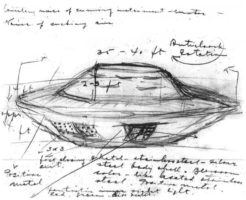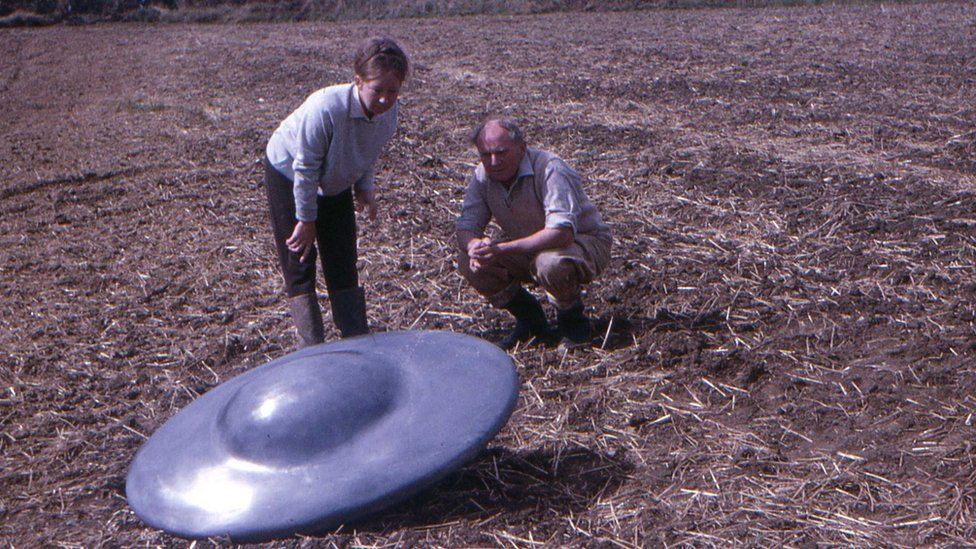by Charles Lear
 1967 was quite a year in UFO history. In Canada there was the Falcon Lake Incident, where a man with a grid pattern of circular burns on his torso claimed to have gotten them from an ascending UFO, and the Shag Harbour Incident, where a UFO was seen to plunge into the water by citizens and was subsequently searched for by Canadian officials. Meantime, here in the U.S., the Air Force funded UFO study at the University of Colorado headed by Dr. Edward Condon was underway as was a major flap, which included UFOs sighted around nuclear weapons facilities at Malmstrom Air Force Base in Montana. A bit of history that’s been all but forgotten is an incident that year that involved six grounded flying saucer-shaped objects in England. They caused quite a stir and were examined by the British intelligence service, the Army, the RAF, a bomb disposal unit and police.
1967 was quite a year in UFO history. In Canada there was the Falcon Lake Incident, where a man with a grid pattern of circular burns on his torso claimed to have gotten them from an ascending UFO, and the Shag Harbour Incident, where a UFO was seen to plunge into the water by citizens and was subsequently searched for by Canadian officials. Meantime, here in the U.S., the Air Force funded UFO study at the University of Colorado headed by Dr. Edward Condon was underway as was a major flap, which included UFOs sighted around nuclear weapons facilities at Malmstrom Air Force Base in Montana. A bit of history that’s been all but forgotten is an incident that year that involved six grounded flying saucer-shaped objects in England. They caused quite a stir and were examined by the British intelligence service, the Army, the RAF, a bomb disposal unit and police.
On September 4, 1967, British authorities became alarmed as six identical saucer-shaped objects, approximately four feet in diameter and making beeping and hissing noises, were reported to be lying on the ground across England. They were roughly equidistant and lying along the 51.5° parallel running from Kent to Somerset.
One of the saucers was found in Bromley, after Cynthia Tooth told the local paper that she had seen a strange light descend behind some trees as she watched it through her bedroom window. The Bromley Police brought it to the station and informed Scotland Yard of the find. Later, they received a reprimand from senior officials at Scotland Yard for bringing the object through town and risking contamination. Scotland Yard then informed the Ministry of Defense just after 9:00 a.m.
Once the MoD was informed, they took control. The senior flight lieutenant in charge, under the condition of anonymity, told John Keeling, author of “How Big are Little Green Men?,” his thought at the time was ,”Well, s**t, what do we do now?”
The first fear was that the objects were some sort of Soviet weaponry. Radar stations were contacted and asked if anything unusual had been spotted the night before and the reply was negative.
Whether enemy weaponry or alien craft, the handling of the objects had been anything but careful. They had been taken to police stations (one was stored in a lost property office), drilled, punctured, and one in Chippenham was blown up by a bomb-disposal unit. One of the objects that had been drilled into showered police officers with a papier-maché like mess and they proceeded to wash it down a drain.
By the end of the day, the mystery was solved, not by the MoD, but by a reporter who remembered that students at Farnborough’s Royal Aircraft Establishment had built a robot for rag week (in British universities, a week devoted to raising money for charity) at around the same time the year before. A press conference was arranged and Farnborough students admitted that they had been the ones responsible for the saucers. One stated, “We believe that flying saucers could land some day, so we landed our own to give the authorities some practice.”
 The saucers were made from two fiberglass halves formed in plaster molds. They were filled with battery powered electronic sound producing equipment that was turned on by a switch that was activated by turning the saucer upside down. To give them the appearance of being alien, they were also filled with a mixture of flour and water that fermented to make a hissing, foul smelling slime.
The saucers were made from two fiberglass halves formed in plaster molds. They were filled with battery powered electronic sound producing equipment that was turned on by a switch that was activated by turning the saucer upside down. To give them the appearance of being alien, they were also filled with a mixture of flour and water that fermented to make a hissing, foul smelling slime.
The students spent the night before setting the saucers out at their locations along the 51.5° parallel. They managed to do so undetected and were safely back in Farnborough by the time the first saucer was found.
The British authorities were embarrassed, but chose not to press charges, as that would only bring more publicity to what was already an international story. A Bromley officer was quoted as saying, “We are taking it like gentleman.”
The publicity resulted in the Farnborough students raising around £2,000. One of the students involved, Chris Southall, told the BBC in 2017 that things would have turned out differently then, 50 years on: “The times we live in now are much harsher, and I don’t think we could do it now. We would end up in trouble.”
Sources: